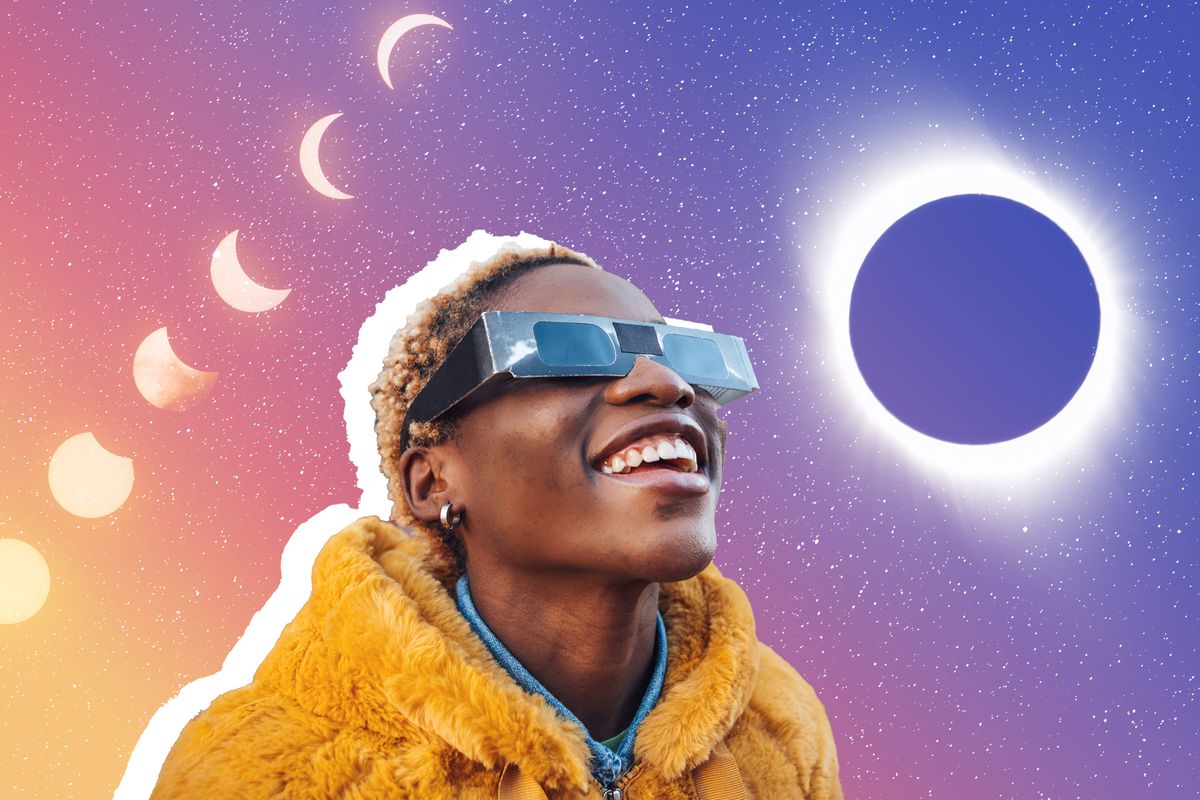
There's going to be a solar eclipse tomorrow, and many people across the Northern Hemisphere (aka the half of the earth north of the equator) will be able to experience it.
But however tempting it is to look at the celestial event that's happening right above you, don't-at least, not without the proper safety precautions. Here's what you should know about protecting yourself before tomorrow's eclipse.
First, what exactly is happening tomorrow?
Knowing why you shouldn't look at a solar eclipse without protection will make better sense once you realize what's going on in the sky. Here's how NASA explains the phenomenon: "A solar eclipse happens when the moon moves between the sun and earth, casting a shadow on earth, fully or partially blocking the sun's light in some areas."
During tomorrow's solar eclipse, the moon won't be blocking the entire view of the sun. Because of this, the moon will look like a dark disk on top of a larger, bright disk. That's going to create what looks like a ring of fire around the moon, which is why people have been referring to tomorrow's eclipse as the "ring of fire" solar eclipse (scientifically known as an annular eclipse). But only people in parts of Canada, Greenland, and northern Russia will actually be able to see that "ring of fire" since they'll be in the eclipse's direct path.
Everyone else in the eclipse's indirect path-the eastern part of the US, northern Alaska, some parts of Canada, and other areas in the Caribbean, Europe, Asia, and northern Africa-will instead be seeing a partial solar eclipse. "This happens when the sun, moon, and earth are not exactly lined up. The sun will appear to have a dark shadow on only part of its surface," according to NASA.
Why shouldn’t you look at a solar eclipse without protection?
So if you were to look at tomorrow's solar eclipse-whether you're seeing the "ring of fire" or partial solar eclipse-you'd essentially be looking at some of the sun's rays. And as NASA points out, "it is never safe to look directly at the sun's rays, even if the sun is partly or mostly obscured," like it will be during tomorrow's eclipse. That's because doing so can cause serious eye damage.
In fact, the sun can burn your retina, a condition medically known as solar retinopathy. "If you lose retina tissue, it's gone forever," Russell N. Van Gelder, MD, PhD, professor of ophthalmology at University of Washington School of Medicine and past president and clinical spokesperson for the American Academy of Ophthalmology, previously told Health. "The risk is that you will irreversibly damage your eye and end up with a blind spot."
How can you safely look at the solar eclipse?
Your regular UV-blocking sunglasses won't cut it; they offer zero defense when looking at the sun during an eclipse, according to Dr. Van Gelder. You will need approved "eclipse glasses"- powerful light blockers that are much darker and much better at blocking out harmful rays. Just make sure the pair you have is stamped "ISO 12312-2" and that the glasses come from the American Astronomical Society's "approved vendor" list.
Not sure if your pair is good? "Your eyes are pretty smart; if you are looking at the eclipse and it's uncomfortable or you are squinting, then you don't have the proper eye wear, and you should look away," Michael Kirk, PhD, a research scientist in the heliophysics science division at NASA's Goddard Space Flight Center with Catholic University of America, previously told Health.
If you can't get access to eclipse glasses by tomorrow, you can use a pinhole viewer. NASA provides step-by-step instructions on how to make your own at home. Just make sure you don't use the device to look directly at the sun; it should be used as a way to project sunlight onto a surface.
Watching the shadows on the ground is another safe way to experience a solar eclipse, according to Kirk.
Regardless of how you choose to safely view the eclipse, you have to make sure you get to a place where you can actually see it: that means somewhere you'll have a clear view of the horizon during sunrise.
Of course, you could also always just watch the livestream of the eclipse (weather-permitting), which NASA is starting at 5 a.m. EDT, in time for the 5:47 a.m. EDT sunrise.
And if the crack of dawn is too early for you to get up and see the eclipse, there will probably be recordings of the event that you can see later in the day-and those will certainly be safe for your eyes.
To get our top stories delivered to your inbox, sign up for the Healthy Living newsletter
Source: Read Full Article
